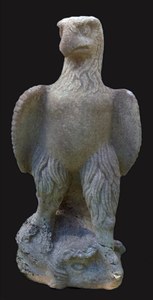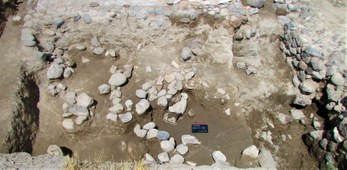Hellenistic finds from ISAW’S Excavations at Niğde Kınık Höyük, Turkey
With the closing of the 2019 excavation season at the site of Niğde Kınık Höyük, the most recent results on the Late Hellenistic occupation of the site are quite impressive and we would like to share them with the ISAW community and the public.
Excavations of the northern portion of the citadel’s summit (Operation E) during the last two campaigns have focused on a monumental, stone-paved plaza opening south of the Achaemenid and Hellenistic citadel walls. This year’s investigations have revealed a series of stone and mudbrick architectural features located at the south-east limits of the plaza. Built above the plaza’s paved floor, these walls attest to active building activity and to various phases of reconfiguration that reshaped this public space throughout the Hellenistic period.
 Sometime in the Late Hellenistic to Early Roman period, part of the plaza’s eastern floor was destroyed, most probably as the result of alluvial events that washed down building debris and mud from the höyük’s top. A large portion of the destroyed paved floor (over 5 meter in width) was completely removed and the preexisting layers below it were cut to accommodate a series of roughly circular pits.
Sometime in the Late Hellenistic to Early Roman period, part of the plaza’s eastern floor was destroyed, most probably as the result of alluvial events that washed down building debris and mud from the höyük’s top. A large portion of the destroyed paved floor (over 5 meter in width) was completely removed and the preexisting layers below it were cut to accommodate a series of roughly circular pits.
A team led by ISAW PhD candidate Nathan Lovejoy had excavated the northernmost pit, which partially cut the fortification walls, in 2018. It contained a slightly damaged marble statue of an eagle perched on the head of a mountain goat (H. 106 cm). The discovery of the monument that we named the Marble Eagle Statue had a world wide impact.
 Immediately to the south, a team led by ISAW Research Associate Roberta Casagrande-Kim excavated a second pit this year. Inside, carefully laid on its back, was a second, slightly smaller (H. 75 cm) eagle, also perched on a mountain goat. Perfectly preserved, the statue retains the original iron tenon used to insert it on a base.
Immediately to the south, a team led by ISAW Research Associate Roberta Casagrande-Kim excavated a second pit this year. Inside, carefully laid on its back, was a second, slightly smaller (H. 75 cm) eagle, also perched on a mountain goat. Perfectly preserved, the statue retains the original iron tenon used to insert it on a base.
Next to it, four fragmentary lines of Greek were inscribed on part of a base of another, now lost, statue. The text is currently being studied by ISAW Professor Emeritus Roger Bagnall and ISAW graduate student Georgios Tsolakis; the preliminary reading provided us with the amazing news of a reference to the cult of Zeus at the site. The deposition of the two eagle statues needs further contextual investigation, but its cultic nature is inescapable, and its motivation opens up a wide range of hypotheses.
Among the alluvial layers that covered these pits, the finding of new fragments of terracotta bovine figures adds to the corpus of zoomorphic and anthropomorphic terracottas found in the 2018 season, and confirms the presence of religious activities involving a local cult of Dionysus, in an area contiguous to the plaza to be explored next year.
Thanks to the very generous support and sponsorship of the company TürkTraktör, following the formal agreement with the Ministry of Culture and Tourism and the Director of the Niğde Archaeological Museum, Dr. Fazıl Açıkgöz, we had the opportunity to proceed with the restoration and reconstruction of the Marble Eagle Statue. This beautiful monument is now newly installed at the Niğde Museum with a didactic panel that addresses the archeological context and the statue’s iconographic motifs.  With her unique expertise as an archaeologist, curator and exhibitions manager, Dr. Casagrande-Kim supervised the work of the architect Dr. Deniz Ucer, and the restorer Nazım Can Cihan and his team, on the Marble Eagle Statues’ installation. Moreover, she oversaw the successful excavation and restoration of the newly found eagle statue, as well as its delicate transfer to the museum. Her contribution to the 2019 campaign has been decisive for the fieldwork results as well as for the installation of the two eagle statues in the permanent collection of the Niğde Archaeological Museum, the first artifacts ever from our excavations to be displayed for the public.
With her unique expertise as an archaeologist, curator and exhibitions manager, Dr. Casagrande-Kim supervised the work of the architect Dr. Deniz Ucer, and the restorer Nazım Can Cihan and his team, on the Marble Eagle Statues’ installation. Moreover, she oversaw the successful excavation and restoration of the newly found eagle statue, as well as its delicate transfer to the museum. Her contribution to the 2019 campaign has been decisive for the fieldwork results as well as for the installation of the two eagle statues in the permanent collection of the Niğde Archaeological Museum, the first artifacts ever from our excavations to be displayed for the public.
The results of the 2019 excavations of the Late Hellenistic remains at Kınık Höyük, as well as the installation of the two eagle statues at the museum, had wide coverage in the media in Turkey.
The excavations, directed by ISAW professor Lorenzo d’Alfonso, are a joint project of the University of Pavia’s Department of Humanities and the Institute for the Study of the Ancient World at New York University. Generous funding is provided by these two institutions and by the Italian Ministry of Foreign Affairs while the local authorities, especially the Special Administration of the Niğde Province and the village of Yeşilyurt, provided fundamental logistical support.
The excavations and study of the classical remains at the site are directed by Dr. Roberta Casagrande-Kim, ISAW Research Associate; by the project’s Vice Director, Prof. Burak Yolaçan, Dokuz Eylül University; and by Prof. Maria Elena Gorrini, University of Pavia.
News Coverage
"Kınık Höyük'te kartal heykelleri bulundu"
Translation: "Sculptures of eagles found at Kınık Höyük"
Articles published by:
Ulusal Kanal
TRT Haber
Posta
Arkeofili
Aksam
Ortadoğu
Ulusal Kanal
Yeni Şafak
Son Dakika
En Son Haber
Aydinpost